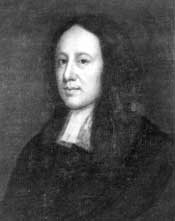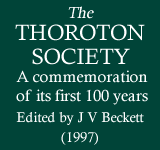ii. Dr Robert Thoroton and the Antiquities of Nottinghamshire (1677)
 |
Dr Robert Thoroton (1623-78) of Car Colston. author of The Antiquities of Nottinghamshire (1677). |
‘The Art of Physick, which I have professed (with competent success) in this County, not being able for any long time to continue the people living in it, I have charitably attempted ...to practise upon the dead’. Dr Robert Thoroton offered that apology to his readers for compiling Nottinghamshire’s first, and greatest, county history. His Antiquities of Nottinghamshire, which appeared in 1677, was one of the classic histories of that era, modelled directly on Dugdale’s Warwickshire.[3] Thoroton was a country physician who lived at Car Colston near Bingham on the edge of the Vale of Belvoir, and who had a far-flung practice among the well-to-do of Leicestershire, Derbyshire and Nottinghamshire. His historical interests seem originally to have been aroused by a fascination with his own family history. Although his family were small landowners who were more yeomen than gentry, Thoroton had proudly traced his ancestry back to the Norman baronial family of Lovetot. He used this expertise in genealogy to compile pedigrees for neighbouring gentry families; he researched at least nine for William Dugdale’s heraldic visitation of Nottinghamshire in 1663. It was Dugdale, together with a member of the county gentry, Gervase Pigot, who first encouraged Thoroton to extend his researches and to record them in the form of a book. As Thoroton reminded Dugdale, in an ‘epistle dedicatory’ to the Antiquities, the occasion was ‘some very few years after your Visitation of our County, you and I being with our Friend Mr Gervas Pigot, since deceased, at his House at Thrumpton’. Pigot produced a transcript of some ancient records together with various antiquarian notes ‘that served to give occasion to both your importunities that I should attempt something further in it...’.[4]
Pigot’s notes were written by Thoroton’s own father-in-law Gilbert Boun, and comprised the beginnings of a projected ‘Description of Nottinghamshire’. Although Thoroton dismisses the notes rather curtly as being ‘only Doomsday Book, and a short note or two on every Town’ (i.e. township), Boun deserves more credit than he has been given. Among Thoroton’s historical collections is a slim manuscript booklet in another handwriting which comprises a brief description of Rushcliffe Hundred and all its lordships, and gives the Domesday Book entry and details of the descent of the manors. The text is headed ‘Chapter the first’ and it can be dated from internal evidence to 1641.[5] This is almost certainly in Gilbert Boun’s hand and must be the notes, or part of the notes, to which Thoroton refers. It is not possible to say whether Boun completed his work for the whole of Nottinghamshire. As feodary for the county it is likely that he compiled the information initially for legal and administrative purposes, but had then arranged it into the draft of a brief history under the name of each manor. Certainly his work formed a foundation on which Thoroton could build.
In researching his book Thoroton visited many churches, copying inscriptions and sketching coats-of-arms, although he paid little attention to the north of the county, farthest from his home. Time was always the enemy, as he made clear in a note next to an unfinished sketch of arms in Holme Pierrepont church ‘which I had not time then to trick out, it being night, and I have not been at Holme since’. Most of his research, however, was based on original archive sources or, in their absence, on transcripts and collections compiled by other antiquaries. Many of these were borrowed from private owners, for example the Rufford Abbey cartulary from Lord Halifax, and extracts from the Pipe Rolls compiled by the Yorkshire antiquary Roger Dodsworth. Lord Fairfax lent the latter through the agency of Dr Vere Harcourt and Gervase Pigot. Modern archivists will wince at Pigot’s explanation in a letter of 1666 that ‘the three volumes of Mr Dodsworth’s collections were sent from hence on a very rainy day, but I made the best defence against the wet that I could devise and hope that they would arrive safe’.[6]
As a busy doctor and often over-zealous JP, Thoroton was unable to visit the major national and regional repositories of archives, particularly the public records in London and the diocesan records at York. In his ‘epistle dedicatory’ he apologized to Dugdale that ‘I could never get opportunity to go myself and stay at York, to abstract what might be useful to me from that Registry, as you ever advised me, and others it seems could not well do it for me, for I had several undertakers who all failed in the point’. From York ‘one of my agents only brought me the titles of certain records, and another a catalogue of the livings-spiritual in the Arch-deaconry of Nottingham...’. After the book’s publication Dugdale repeated the point in a letter to a friend about Thoroton’s work: ‘I do esteem the book well worth your buying though had he gone to the fountain of records it might have been better done’.[7]
As with so many antiquarian works, Thoroton is especially helpful as a source of information on his own times. As a young man he had lived through the Civil War, and although he does not seem to have taken an active role, he was an eyewitness to the troop movements for at least one of the three sieges of Newark; following the third siege in 1646 he commented that the town ‘suffered more by the plague within than the enemy without’. His conservative and almost reactionary political views are frequently expressed on his pages, especially when railing against the evils of enclosure. An early Tudor enclosure at Thorpe-in-the-Glebe had, in his opinion, ‘so ruined and depopulated the Town, that in my time, there was not a House left inhabited of this Notable Lordship (except some part of the Hall...) but a Shepherd only kept Ale to sell in the church!’.[8]
His descriptions of Nottingham are especially valuable, at a time when it was undergoing a post-war boom as a fashionable regional centre: Many people of good quality from several parts, make choice of habitations here, where they find good accommodation’. He observed with wry amusement the building of fine town houses with elegant facades by the new urban gentry, who vied with each other to lead ‘the fashionable dance of building new Fronts in this Town’. His book was illustrated with several well-executed prospects of Nottingham and Newark, as well as views of notable country houses, churches and church monuments, mostly drawn by a Nottingham heraldic and monumental mason, Richard Hall, and engraved by Dugdale’s engraver, the Bohemian exile Wenceslaus Hollar.[9]
Although Thoroton’s work has its deficiencies, for example the absence of information on archaeological remains, his research was thorough and usually very accurate. Nottinghamshire is indeed fortunate to possess such a work from one of the first generation of county historians.
